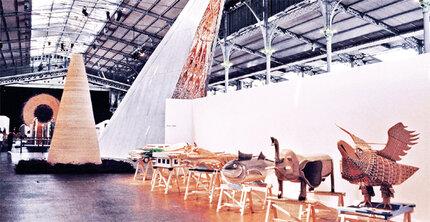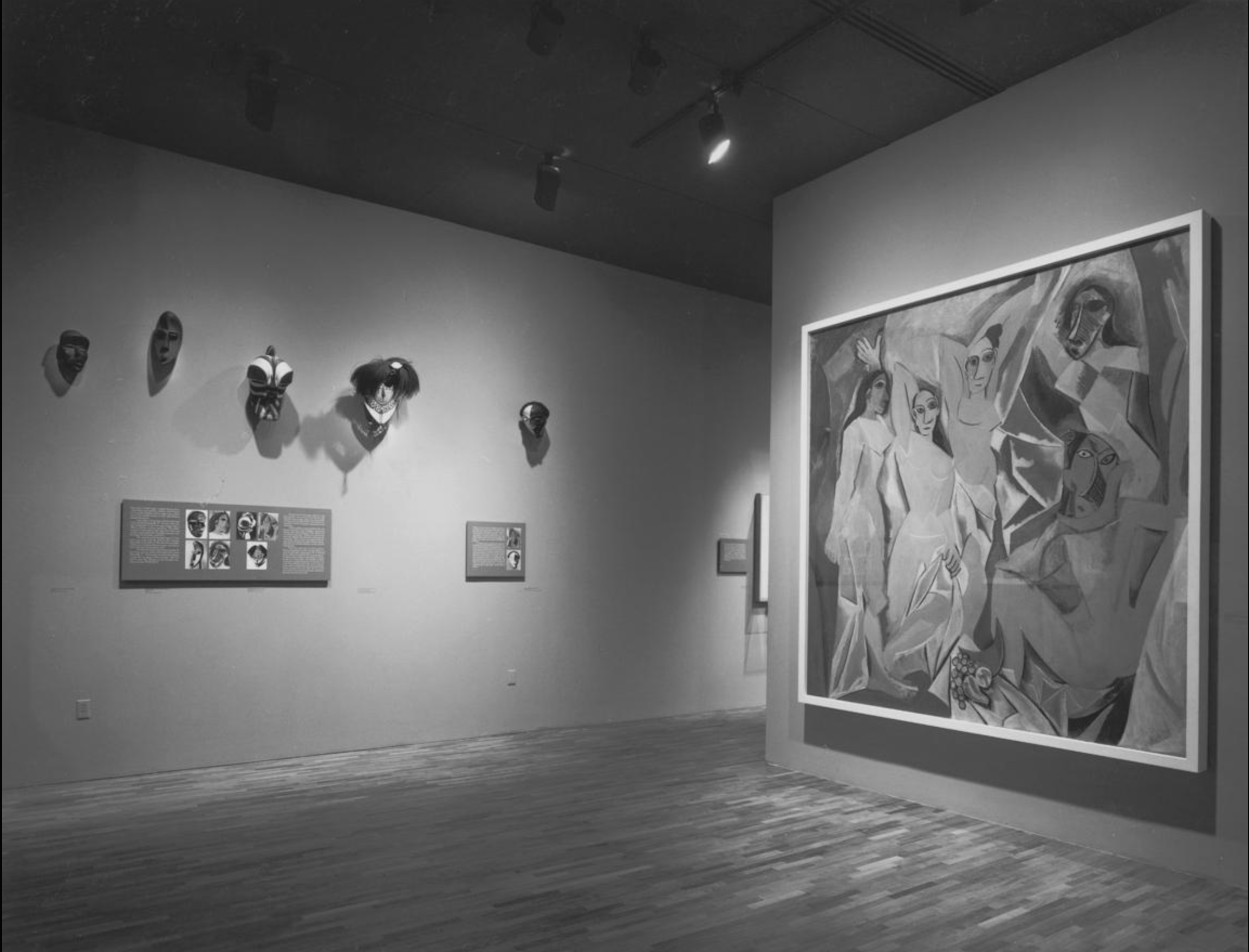Revisiting “Magiciens de la Terre” with Rasheed Araeen through the lens of multicultural exhibition making
Figure 1. Installation view, “Magiciens de la Terre” at the Centre Georges Pompidou and La Grande Halle, Parc de la Villette, Paris, France, 1989. Curated by Jean-Hubert Martin. Accessed 6th April 2021. https:// www.artforum.com/print/201403/making-art-global-45287
Critically re-examining preceding landmark exhibitions in the West is necessary for contemporary non-Western artists and curators to overcome the struggle of exhibiting non-Western identities in the current neo-liberalised art world. Jean-Hubert Martin’s 1989 “Magiciens de la Terre” (Magicians of the Earth) (Figure 1.) is recognised as one of the pivotal moments of exhibition making in the West, exemplifying the moments of encroaching economic and cultural globalisation in the late 20th century, as the “first world-wide exhibition of the world”.1 I would like to draw your attention to a republished spoken essay in Lucy Steed’s “Exhibition - Documents of Contemporary Art” (2014), by the London-based Pakistani artist, Rasheed Araeen. Araeen’s “Magician of the Earth: On ‘Magiciens de la Terre” was given at a colloquium in the Centre Georges Pompidou, Paris in 1989, critically reflecting on his participation in “Magiciens de la Terre” (MDLT). I have studied Rasheed Araeen’s writing extensively in the field of non-Western identities in Western exhibition making. His evocative essay is an influential and compelling statement that explores not only the critique of his participation as an artist within the show but also the broader spheres of Western exhibition making. “Magician of the Earth: On ‘Magiciens de la Terre” is a powerful revelation of the intricate and perplexing tensions of exhibiting non-Western identities and art within a culture of commodity fetishism and cultural exoticism.
Jean-Hubert Martin selected over 100 Western and non-Western artists to attempt to grapple with the “relationship of our culture (Western) to other cultures of the world”2 underpinned by the mystifying and ahistorical idea of ‘magic’. “MDLT” was a response to MoMA’s“Primitivism”3 exhibition in 1985 (Figure 2.), which was largely criticised for its reductive and Eurocentric curatorial direction. ‘Primitive’ and tribal works were juxtaposed in opposition to Western Modernist works to highlight its formalist similarities and essentialist cultural differences. Refracting from “Primitivism”, Martin was provoked to provide an equal ground for Western and non-Western artists that were within the centre and periphery of international Contemporary art. Nonetheless, differentiated discourses and opinions of “MDLT” emerged from artists that were in the margins of Contemporary art. Many non-Western artists, writers and audiences sought to challenge the overarching cultural and historical frameworks of Martin’s exhibition. From there, many questioned the possibility for an equal exchange between the ‘centre’ and ‘periphery’ from Martin’s ‘single point of view’ exhibition making.
Figure 2. Installation view of the exhibition “Primitivism” in 20th Century Art: Affinity of the Tribal and the Modern, September 19, 1984–January 15, 1985. Accessed 6th April 2021. https://www.moma.org/ interactives/moma_through_time/1980/the-infamous-primitivism-exhibition/
The recognition of power imbalance is necessary to unveil the hegemonic centre that possesses the authority to re-write and produce dominant narratives. Rasheed Araeen begins his essay with a personal positioning, declaring himself as a subject of British Imperialism, and a Pakistani artist whose native languages are Punjabi and Urdu. I would like to follow that thread, and make known that I am a first generation Chinese-Australian immigrant, and prevail under the systems of colonial and racial capitalist imperialism. My mother tongue spoken at home is the FuZhou dialect, alongside Mandarin. I believe it is vital to position oneself in order to confront and articulate the structures of power that are active in our everyday lives, the colonial languages we speak and the colonial institutions in which we attend. For this reason, it is imperative to recognise the inextricable relationship between self-positioning and agency.
“Magiciens de la Terre” neither overturned nor negated the centre-periphery model of exhibition making or the exotic spectacularisation of non-Western creative practices and culture. Through his own involvement, Araeen confronts the asymmetrical power structures that were perpetuated throughout the exhibition, unveiling the self-serving interests of the West. Thus, the works of the ‘Other’ and ‘Third World’ cultures were exploited to reinforce Western Modernist philosophical traditions, upholding its universalist imperatives.4 Martin merely confined the non-Western artists and artworks into exotic traditions and unmoving entities of mythology and ‘magic’, rendering Araeen’s position as a contemporary artist “invisible”.5 Non-Western art employed as spectacularised and exotic objects within the ‘white cube’ model are commodified to emphasise the tensions between contemporaneity and tradition in ‘Third World’ cultures. The decontextualisation of the works exacerbated the displacement of non-Western voices within the curatorial decisions and international discourse.6 Caged by the lens of Western aesthetic criteria and Modernism, the exhibition “grossly misrepresented”7 India by homogenising the nations Modernist aspirations to folk and religious traditions, illustrating the power of exhibitions and Western curatorial voices to render marginalised practices powerless. Martin privileged non-Western artists that worked with ‘traditional’ materials, and fetishised the ‘mythological’ aesthetic of non-Western spirituality and religion.8 This fetishism of ‘traditionalism’ merely reinforces the static categorisation of non- Western culture and people, resulting in an unequal dialogue between the West and the ‘Other’.9 The absence of any radical theory and conceptual underpinning or intervention of power displaced the social and cultural realities of non-Western nations exhibited, diminishing any possibility of equal dialogue between the two contexts.10 In Araeen’s view, “art has always been produced in relation to the dominant system”11. Therefore, “MDLT” is emblematic of the hierarchical systems of Western cultural imperialism and Modernism, situating the non-Western works as a grand spectacle of exotic fascination. These methods of regulation sustain the power for Western structures to withhold the hegemony in reproducing the dominant culture. As Jean Fisher denotes, “despite the curators’ well-intentioned desire to create such a two-way dialogue between cultures, in the end, dialogue failed to take place.”12 The perpetuated division between non-Western Contemporary art and contemporaneity, delimited non-Western creative practices to aestheticised folk, and spiritual traditions.
In a similar vein on non-Western exhibition making, Puerto Rican curator Mari Carmen Ramirez’ “Broken Identities - Art curators and the politics of cultural representation” (1996), illustrates how marginalised identities are commodified and marketed upon their notion of essentialist cultural differences and “desired otherness”.13 Ramirez exemplifies that the art world drives towards the integration of ‘multicultural’ trends of exotic cultural attributes and symbols but only within the parameters of the ‘international’ standard. The international arena demands both the commodification of cultural exoticism and the erasure of heterogeneity at its own self-serving terms. Ramirez and Araeen are concerned with the fetishism of the ‘exotic Other’ and how it displaces the space and capacity for non-Western artists to self-determination and representation. The colonial emphasis on the ‘traditional’ and ‘authentic’ maintains the structures of hierarchy and systems of regulation that subjugate people through exoticism and objectification.14 As a result, many art historians are urging for the “dethroning of Western-centred narratives of artistic Modernity altogether”, to acknowledge the multiplicity of Modernities and artistic conditions from different cultures.15 The dominant Western frameworks of Modernity that were imposed against the “Third World” artists, fossilised and mummified their capacity for self-invention.16 For this reason, Ramirez offers an alternate approach, urging curators to turn to the pluralism of identity, the differences and contradictions of marginal artists.
The institutional power of exhibitions to commodify non-Western artists for their “desired otherness”17 continues to remain present in the international art arena. Araeen’s evocation stands as a testimony of the problematics of Western-centrism in Martin’s exhibition making, illuminating the need for plurality in curatorial voices that can support in negating ethnocentricism and homogeneity in exhibition making. However, in recent times non-Western artists and curators have revisited the exhibition with recognition. “MDLT” was a landmark exhibition in the history of multicultural exhibition making, Paris-based Chinese curator Hou HanRu argues that the “opening up towards the “unknown Other” was not only a new trend but also a necessity for the intellectual and social survival of the creative community”.18 With this in mind, it is critical to address the subjective nature of Araeen’s writing and to consider all facets of criticism, resistance and recognition of the exhibition. Araeen’s account is not emblematic of a universalised experience for each participating artist. Much rather, it is a reflection of Araeen’s introspection of the struggles and frustration of entering the Western art discourse at the time, entangled by the alienating structures of Eurocentrism. In defence of “MDLT”, Hou argues Martin provided the opportunity and platform for non-Western artists, such as the Chinese Avant-garde, to confront and enter the international art discourse. Since then, we have all witnessed the explosive expansion of non-Western representation among the neo-liberalised international art circuit of biennials and mega-exhibitions, as “exhibitions have become the medium through which art becomes known, as primary sites of exchange”.19“MDLT” brought new interpretations, inventions and discourses into the forefront of the local and global arts ecology. The contrast between Araeen’s visceral reflection and Hou’s critical re-examination of “MDLT” is indicative of the momentous impact of the exhibition and the differentiated discourses that have emerged from it. Nevertheless, both responses are reflective of the contemporary globalised art world that is propelled by institutional forces, media and capitalism.20
A critical re-examination of “MDLT” can offer us the necessary tools and alternatives to transcend homogenising cultural visions of the West. Rasheed Araeen’s evocation is a valuable reminder of the purpose in the confrontational process of reflection and re-examination, which allows for the capacity to re-contextualise and construct one’s interpretation and understanding of such a pivotal moment in exhibition making. I believe his essay continues to situate and contextualise the voices of many non-Western artists, as well as aspiring curators like me who are seeking to resist the homogenising forces of the neoliberal art arena. Araeen reconfigures the dominant narrative and curatorial underpinnings of “MDLT” through his uncompromising tone and confronting articulation of his experience. His determined attitude deepened my understanding of the dilemmas and tensions of curating and negotiating with non-Western identities within the Eurocentric neo-liberal art arena. In the hopes for “Magiciens de la Terre” to “not be the end of everything but the beginning of a meaningful debate”21, Araeen has paved the way for the new trajectory and reconfiguration of exhibition making.
Araeen, Rasheed. “Magicians of the Earth: On ‘Magiciens de la Terre’- 1989”, in Exhibition: Documents of Contemporary Art, ed. Steeds, Whitechapel Gallery and MIT Press, 2014.
Araeen, Rasheed. "Our Bauhaus Others' Mudhouse”, Third Text 3, no. 6, 1989. Accessed 3rd April 2021. https://doi.org/10.1080/09528828908576208
Buchloh, Benjamin H.D, and Martin, Jean- Hubert, Interview, Third Text, 3:6,1989. DOI: 10.1080/09528828908576210.
Clarke, David. “Contemporary Asian Art and its Western Reception”, Third Text, 16:3, 2002. p.241.
Fanon, Frantz. “Racism and Culture”, speech at the First Congress of Negro Writers and Artists in Paris, September 1956, cited in Araeen, Rasheed. “Magicians of the Earth: On ‘Magiciens de la Terre’- 1989”, in Exhibition: Documents of Contemporary Art, ed. Steeds, Whitechapel Gallery and MIT Press, 2014.
Fisher, Jean. “Fictional Histories: Magiciens de la Terre - The Invisible Labyrinth”, Artforum International, September 1989. Accessed 1st April, 2021. artforum.com/print/reviews/198907/magiciens-de-la-terre-in-paris-34359
Greenberg, Reesa , Bruce W. Ferguson & Sandy Nairne. “Thinking About Exhibitions”, ed. Greenberg, Ferguson & Nairne . London & New York: Routledge, 1996.
Hou Hanru. “In Defense of Difference: Notes on Magiciens de La Terre, Twenty-Five Years Later.” Yishu: Journal of Contemporary Chinese Art, 13, no. 3, 2014.
Ramirez, Mari Carmen. “Broken Identities - Art curators and the politics of cultural representation”, Thinking About Exhibitions, ed. Greenberg, Ferguson & Nairne, London & New York, Routledge, 1996. Accessed April 4th, 2021.
https://ebookcentral-proquest-com.ezproxy.lib.monash.edu.au/lib/monash/detail.action? docID=242218
Ratnam, Niru. “Globalization and art.” Grove Art Online, Oxford University Press, 2010. Accessed 6th April, 2021. doi: https://doi.org/10.1093/gao/ 9781884446054.article.T2086277

